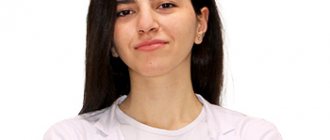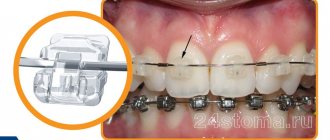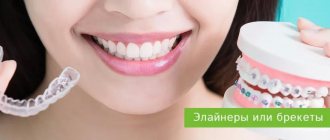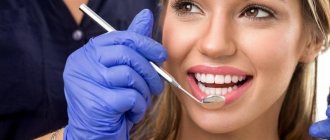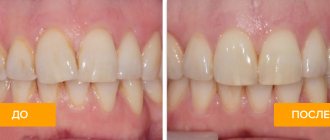A well-known German manufacturer of orthodontic products, Forestadent, supplies the market with two lines of modern, high-quality and effective brace systems - Quick and QuicKlear. The first series combines traditional metal solutions with a low profile, which make the treatment process as comfortable as possible. The products are made from a high-quality alloy that does not contain nickel, which most often provokes the development of allergies.
QuicKlear systems are aesthetic, self-ligating ceramic structures. The company’s specialists managed to improve the material, giving it maximum strength and at the same time maintaining the highest aesthetics. The plates on the teeth literally merge with the color of natural enamel, making the system almost invisible.
A few words about the manufacturing company
With such a wide variety of modern brace systems, it can be quite difficult to choose the option that best suits your specific expectations and financial capabilities. If you want to get results as quickly as possible and not experience discomfort during treatment, you should immediately pay attention to braces from the German manufacturer Forestadent - the Quick brand.
The history of the company dates back to the middle of the last century in the city of Pforzheim in Germany. To date, the company occupies one of the leading positions in the global market, continuing to improve its technologies and developments in the production of modern high-quality and comfortable brace systems.
The first model of braces from Forestadent was presented to the world in the 70s of the last century. And most recently, the company patented a new base for brackets - the special design of the platform ensures the most accurate placement and strong fastening of each plate. Today, the manufacturer’s assortment includes many different models for the treatment and prevention of dental anomalies of varying degrees of complexity and etiology.
History of Forestadent
Forestadent is one of the world leaders among manufacturers of high-quality bracket systems.
Having a history of more than half a century, the German company created its first system back in the 70s of the twentieth century. Since then, Forestadent has been constantly improving its braces manufacturing technology.
For these purposes, large-scale research is carried out, on the basis of which the company’s specialists modernize their products, bringing to perfection the convenience and elegance of appearance.
The main principles in working with the company’s new line of bracket systems are maximum naturalness and aesthetics of the products.
In search of a solution to make braces on teeth as invisible as possible, manufacturers came up with the idea of using translucent ceramics to make systems. Innovative solutions also affected the classics - all-metal braces.
The Quick line has been developed taking into account all new trends in orthodontics and is considered one of the most high-tech systems.
Features of Quick systems
The Quick line is a series of self-ligating vestibular systems made entirely of metal or with ceramic plates. Several models are presented here, designed for different clinical cases, with active and passive types of ligation. The following characteristics distinguish Quick designs from braces from other brands:
- in metal models there is no nickel in the alloy, and this almost completely eliminates the risk of developing an allergic reaction,
- the plates that are fixed on the incisors have a low profile, which provides increased comfort and aesthetics for the patient,
- each bracket has rounded edges - this eliminates the risk of rubbing and permanent injury to the mucous membrane during correction,
- each bracket has an additional groove, which makes it easier to fix auxiliary elements if necessary,
- anatomically shaped platform with grooves – the company’s patented technology. The base literally adapts to the anatomical features of each individual tooth. The grooves allow the use of a larger amount of adhesive composition for even stronger fastening of the plates to the enamel,
- The new archwire clamp increases the strength of archwire retention in the grooves by almost 20%. This feature allows you to better control the pressure of the power arc on the dentition1,
- the ability to quickly repair individual fragments without the need to remove the entire system.
Ceramic braces look quite aesthetically pleasing on the teeth.
In German braces, all parts are made in compact sizes; there are no massive protruding components. Some experts believe that, along with the Sprint and aesthetic sapphire Aesthetic models, the Quick line for Forestadent has become one of the most successful, since each of the models presented in it gives a quick and high-quality result without much discomfort for the patient .
Excellent transparency
After three years of intensive research, FORESTADENT engineers managed to develop a new ceramic mixture. It combines unique mechanical hardness and crystal transparency. Thanks to their high transparency, Quick Clea braces merge with the surface of the tooth, and patients can show off their dazzling smile to others without hesitation.
The patented base of the new Quick Clear ceramic braces allows for easy and safe removal:
The base area is made in the form of protrusions and provides reliable mechanical fixation. Quick Clea braces are not only securely fixed to the surface of the tooth, but can also be easily removed at the end of treatment. Chipping of the enamel is impossible, since all the material remains on the surface of the tooth when the braces are removed.
Occlusal-gingival edges prevent glue from getting into the clamping mechanism when installing braces. These edges also allow for easier removal of excess material during positioning.
FORESTADENT's new simplest tool for removing Quick Clea ceramic braces ensures safe, splinter-free removal. Simply position the instrument parallel to the occlusal plane and press the distal side of the instrument handle.
Highly efficient force transmission
Rounded groove corners, as well as four rounded contact points in the groove with minimal contact area, provide controlled force transfer with minimal friction.
Types of Quick braces
- Quick BioPassive: A passive form of ligation design that has a deeper groove in the plates, giving the arch more space. Due to this feature, the friction force is reduced, but the pressure on the teeth increases and the process of their correction is accelerated,
- BioQuick: BioQuick metal systems with a low-profile self-ligating design cope even well with complex dental anomalies and at the same time provide increased comfort during treatment,
The photo shows BioQuick braces - QuicKlear: self-ligating ceramic braces are aesthetic models and therefore cost more to treat. There is a “Clea” model without metal parts, and this is an excellent option for patients prone to allergic reactions to metal. In another variation, the ceramic plates are reinforced with metal clips and are a suitable choice for more complex anomalies.
This is what a QuicKlear brace looks like
Obvious advantages:
More convenient placement of the arch in the groove, especially at the stage of teeth alignment with severe crowding.
More accurate results, especially when using full-length archwires.
The perfect combination of aesthetics, precision and efficiency
In the aesthetic zone, we recommend using Quick Clea braces, while on all other teeth we recommend using metal nickel-free Quick Clea braces. This simplifies the introduction of a new system into your daily practice without significantly increasing the cost of treatment. If you use other braces in combination with Quick Clea, as well as full-size arches, you may need additional compensatory bends of the arch to compensate for the difference in the height of the slots of braces of different systems. Thanks to the rounded edges of the groove, coated arches (aesthetic arches) can be used in the Kwik Clea and Kwik systems. Until now, these wires were not recommended for use in metal or ceramic slot brackets due to chipping of the wire coating and increased friction. To achieve perfect aesthetics, we recommend using and regularly replacing Titanol coated nitinol archwires from FORESTADENT. These arches have excellent aesthetic and mechanical properties.
Are there any disadvantages
Like any other orthodontic system, Quick is not without its drawbacks. Of course, there are very few of them when compared with other corrective devices, but the disadvantages also cannot be ignored:
- the relative aesthetics of metal models - the material differs in color from the enamel, therefore, in any case, it stands out against the background of the teeth, despite the low profile and compact size of the plates,
- high cost of treatment - during production, the company spends significant funds on new developments and their implementation, and this inevitably affects the final cost of the structures,
- the adaptation period is inevitable, regardless of the chosen system and its brand. Diction and chewing functions are fully restored within 1-2 weeks.
The photo shows BioQuick braces
After installing the structure, you will not have to radically change your usual lifestyle. You will need to pay more attention to hygiene and give up too hard foods, such as seeds and nuts. Otherwise, there is no need to make any special efforts or set strict limits for yourself.
Indications for installation
The range of possibilities of Quick braces is quite wide. Their installation may be indicated in the following clinical cases:
- anomalies in the structure of the dental system of various etiologies and degrees of complexity,
- crooked position of the teeth, including crowding, large gaps between teeth (tremes and diastemas) or their severe rotation,
- curvature of the coronal part along with the roots.
Such designs are used for various malocclusions.
Correct correction not only makes teeth straight and beautiful, but also normalizes the functionality of the dentofacial apparatus. After treatment, problems with breathing and speech disappear.
What contraindications can be identified?
Treatment with Quick braces may not be possible in all cases. Plates are not installed in cases of increased sensitivity of the enamel (hyperesthesia), acute inflammation of the gums and periodontal tissues, tuberculosis, serious disorders of the nervous system and psyche, pathologies of the endocrine and circulatory systems, as well as poor oral hygiene. Plates will also not be placed if there are untreated carious lesions in the mouth or a large number of fillings and crowns.
It is recommended to begin orthodontic treatment with fixed appliances at the age of 12-13 years, not earlier. It is necessary to wait until the process of formation of the child’s dental system is completely completed. At an earlier age, correction is carried out using removable plates or soft trainers.
Why do you need teeth straightening?
The desire to straighten teeth in patients is most often caused by aesthetic reasons. Incorrect bite, uneven teeth - they do not affect anything other than a smile. This is not appendicitis, not a stomach ulcer. However, as practice shows, every second patient with such problems needs dental correction.
What problems can be avoided if you correct uneven teeth:
- premature destruction of teeth due to uneven load on them during chewing;
- risk of periodontal disease;
- facial asymmetry;
- unclear diction.
Dentists distinguish between several types of bite defects - they not only spoil the smile, but can distort the face and provoke diseases of the gums and gastrointestinal tract. Correcting the dentition and bite using mouth guards, braces, and plates will help to avoid this.
Preventive measures to reduce the risk of malocclusion should be taken in the first years of a child’s life. It even matters what shape his pacifier was, and when the child was weaned off the pacifier.
It is very important to visit your dentist regularly. The sooner the doctor makes a diagnosis, the sooner the planned course of treatment can begin. Although braces are placed after the jaw bones have formed, that is, after 11-14 years.
Approximate treatment time
The self-ligating design of Quick braces speeds up the correction process. It also allows you to fix additional elements at any time for more accurate and effective correction. To correct minor defects, 6 months is usually sufficient. In more complex cases, it may take from 1 to 1.5 years. Some serious defects require more time.
To correct minor defects, 6 months of treatment is usually sufficient.
“I had one like this on my upper jaw, Quick. Some teeth were crooked, but nothing serious. The doctor immediately told me that it was better to choose a metal system, it would be faster. In my case, they immediately announced a period of one and a half years. In fact, it turned out even less. My teeth have straightened and I’m happy with the result.”
Igor, from correspondence on the forum www.32top.ru
The doctor will definitely inform you about the approximate time of treatment after a careful visual examination and examination of x-rays. The duration of correction directly depends on the complexity of the anatomical anomaly and the age of the patient. The Quick system refers to non-ligature braces, and therefore you will have to visit the orthodontist during treatment no more than once every 2-3 months.
Myths
Braces, the only way to correct abnormalities in the structure of the jaw and teeth, have been known for a long time, but myths associated with wearing them still circulate among ordinary people. The new Quick ceramic systems have given rise to several more prejudices:
- Treatment with ceramic structures is the most expensive. The Quick Clear line from Forestadent is close in price to its analogues. Ceramic systems are by no means the most expensive in their niche.
- The wearing period of ceramic models exceeds the period of treatment with metal systems.
The main role in determining the timing is played by other factors - age, individual characteristics of the patient’s jaw structure, and the degree of impairment.Ceramic structures, like other Quick braces, thanks to innovative technical features make the wearing period of braces optimal.
- Braces change color when exposed to food coloring. All parts of the product are highly resistant to dyes contained in food products.
The video provides additional information on the topic of the article.
Care during the correction period
The Quick bracket system is distinguished by the compact size of the plates and their tight fit to the enamel. This eliminates the risk of gaps forming and bacteria multiplying in them, which can lead to caries. During correction, it is important to ensure proper and complete care of teeth and braces. In this regard, experts in the field of orthodontics provide the following recommendations:
- brush your teeth twice a day, including with a special brush-brush for high-quality cleaning of structural elements,
- rinse your mouth every time after eating, use preventive antibacterial rinses,
- It is advisable to purchase an irrigator - a small device for supplying a high-pressure air-water jet, which effectively removes food debris and plaque from hard-to-reach places.
When using braces, it is recommended to use an irrigator.
With Quick ceramic braces, you don’t have to worry about staining the plates. They do not change their color under the influence of coffee, natural juices and other coloring drinks. However, during orthodontic treatment you will have to give up too hard foods, sticky sweets, chewing gum, seeds and nuts. All hard vegetables and fruits should not be bitten off; it is better to cut them into small pieces. Attentive attention to oral hygiene during the course will help to avoid many problems after removing braces.
How much does installation cost?
The cost of installing the Quick bracket system on one jaw varies from 35 to 40 thousand rubles. Models from this line do not belong to the budget price segment, but they guarantee quick and effective correction of dental defects of any complexity. The exact price will depend on the chosen model and the complexity of the clinical case. In addition, after installation you will have to pay for each doctor’s visit (every 2-3 months), if this is not a “turnkey” correction. Therefore, it is better to discuss the full cost of the course with the orthodontist in person.
- According to the manufacturer at the office. website: forestadent.com.

